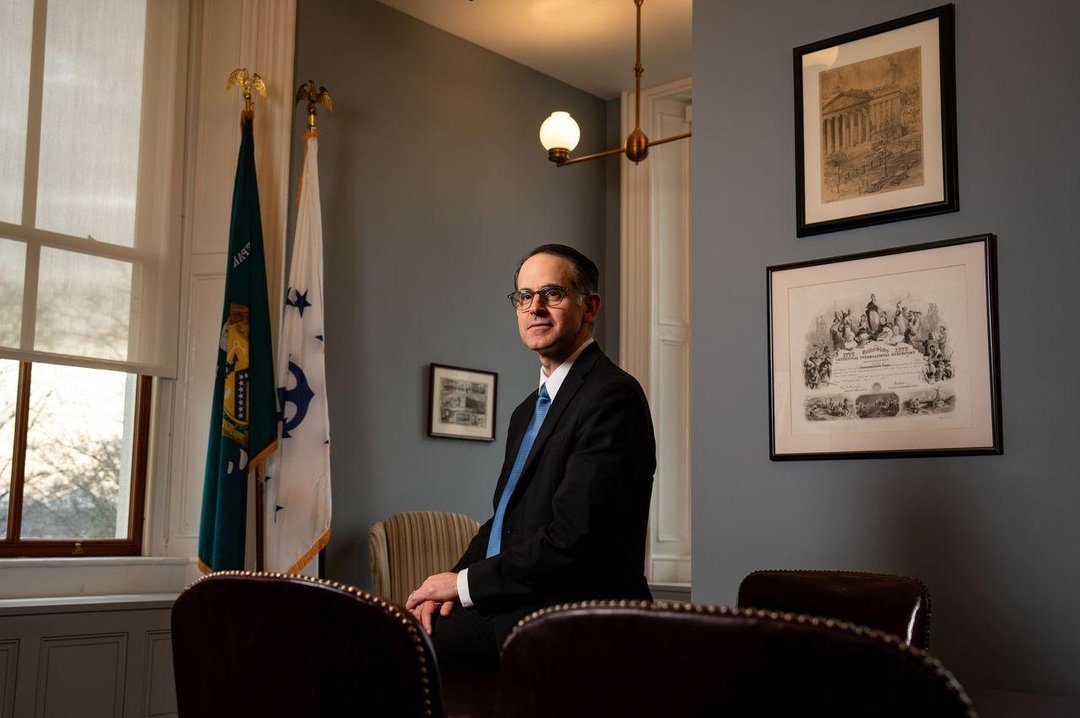
By Andrew Duehren
Jan. 28, 2024
Josh Frost’s low-profile job is suddenly a Wall Street obsession.
As the Treasury Department’s assistant secretary for financial markets, he sets the mix of U.S. government bonds sold to investors, a process guided by the department’s mantra to be “regular and predictable.”
So he found it odd last year when his phone started lighting up with texts from friends and former colleagues telling him that CNBC’s Jim Cramer had crowned him “the most important man in finance.”

Kent Nishimura for The Wall Street Journal
It had been a tough couple of years in the world’s most important bond market. Unprecedented losses sparked a wave of bank failures last year, and investors were skittish about buying debt. Frost, 47 years old, had offered them some relief—and is now at pains to go back to being a humdrum player in the unpredictable, occasionally raucous market.
The latest test of his approach will come next week, when the Treasury announces its quarterly refunding plans, now a key factor not only for the cost of paying for the national debt, but also for Americans looking to borrow to buy cars or homes.
To prepare, Frost and a half-dozen members of his team headed to New York on Thursday and Friday to meet with investors across Wall Street, arriving on a 6 a.m. flight into LaGuardia. (The federal government will pay for coach seats on the morning plane, but not seats on the business-class Acela). As Treasury’s point man for surveilling financial markets, Frost has a list of more than 100 people he says he tries to keep up with regularly, and some investors say they sometimes hear from him two or three times a week.
His goal is to gauge investors’ constantly evolving demand for the suite of securities he can offer them. Longer-term debt typically offers investors a better return over time, but its value is more sensitive to whipsawing expectations about the economy and interest rates. “We need to consider where the market is in terms of structural demand. We control the supply, but we don’t control the demand,” he said in an interview.
The decisions he, Treasury Secretary Janet Yellen and other department leaders make about the composition of billions in short-term bills or long-term bonds available in the market fueled both a bond-market rout and a rally last year. “I think Josh stepped into the role in one of the most complicated moments for debt management in U.S. history,” said Daleep Singh, a former Treasury and White House official.
Frost has been immersed in the plumbing of financial markets for his whole career. After graduating from Rutgers University with a degree in math and psychology, he started in back-office operations at the New York Fed, where he ultimately spent more than 20 years.
There, as he climbed the ranks, he earned a reputation for his attention to detail. When he spotted an error in a more junior staffers’ work, he would be sure to let them know. This became such a frequent occurrence that people at the New York Fed coined the term getting “Frosted” to describe it. Frost said he’s now more mindful about how he delivers feedback to staffers in their 20s—but stands by being a stickler.
“Yes, I place value on attention to detail,” he said. “I think it’s hard to do this job well without that. I think, ‘Meh, we’ll figure it out,’ when the national debt is at stake, is probably not the right attitude.”
After the meetings in New York, Frost returns to Washington, where more than a dozen senior executives from Wall Street’s biggest banks and hedge funds come to convene with him before the decision. The last time the group gathered—on Oct. 31 in Treasury’s Cash Room, built after the Civil War to resemble an Italian palazzo—the bond market was caught in what seemed to be a perfect storm.
Robust economic data had raised the possibility that the Fed would have to hold interest rates high for longer. And the deficit for the prior fiscal year had turned out to be larger than forecasters had expected, meaning Treasury had to sell more debt to pay the government’s bills just as demand was softening.
The result was a rapid run up in long-term rates, which rose as prices fell; the yield on the 10-year note had been scraping 5% in the days before. The group, Treasury’s borrowing advisory committee, debated whether Frost should pull back on the amount of long-term debt he offered the following day.
Frost mostly listened as a minority of the group said he should deviate from the previous quarter’s plans and reduce the size of the increase in long-term debt, according to the meeting’s minutes. The advisory committee recommended that the Treasury stick to a plan similar to the one it made in August.
Then the group broke up in the afternoon to give many of the attendees time to get back to New York to go trick-or-treating with their children. Frost followed suit in Washington, dressing up as a hot dog to join his wife and daughter, who went as characters from the 2015 Disney film “Descendants.”
The next morning, Nov. 1, Frost revealed the Treasury’s decision. He and other Treasury officials had listened to the minority and cut back on the size of increases in 10-year and 30-year debt auctions. He also signaled a willingness to rely more on short-term debt, which investors have been happy to snap up.
The plan, while only a tweak from what most investors had expected, was a pleasant surprise across Wall Street. A bond rally emerged, with the 10-year yield eventually dropping below 4% in December. Cramer, the CNBC host, was thrilled, dubbing Frost the “savior of the bond market.”
Yellen brought up Cramer’s segment in a staff meeting, offering to show other Treasury officials the clip on her phone, according to people familiar with the event. But as she searched in her bag for her phone, Yellen realized it wasn’t there because she was meeting in a secure room where cellphones are barred, according to the people. So she couldn’t actually show the clip.
“It was an odd week,” Frost said. “The refunding is always a big deal to Treasury. The fact that other people are interested in it is more notable, interesting. I don’t know what the right adjective is here, but it’s not really changing what we do or how we do it.”
Some analysts saw something more ominous in the reaction. To them, the minor deviation from expectations raised questions about Treasury’s commitment to its “regular and predictable” strategy, an approach adopted in the 1970s to reduce market volatility and lower borrowing costs over time.
Stephen Miran, a Treasury official during the Trump administration, said a surprise again next week could start to erode market expectations about Treasury issuance. “If they repeat what they did in November then you run the risk of changing the rules of the game,” he said.
Frost rejected the idea that the November refunding moved away from the “regular and predictable” paradigm, saying the decision was well within the range of investor expectations. His team’s commitment to traditional management ideas has not changed, he said.
With next week’s borrowing decision, Frost and the Treasury will be in an easier spot than in November. Investors are now forecasting the Fed to begin cutting rates soon, rather than hold them high for longer, helping support demand for long-term Treasury bonds.
Still, the uncertainty around economic conditions, Fed policy and the growth in the deficit will quickly occupy Frost and his team again. “Right after the refunding ends, we start planning for the next one,” he said.
Write to Andrew Duehren at andrew.duehren@wsj.com
Dow Jones & Company, Inc.



